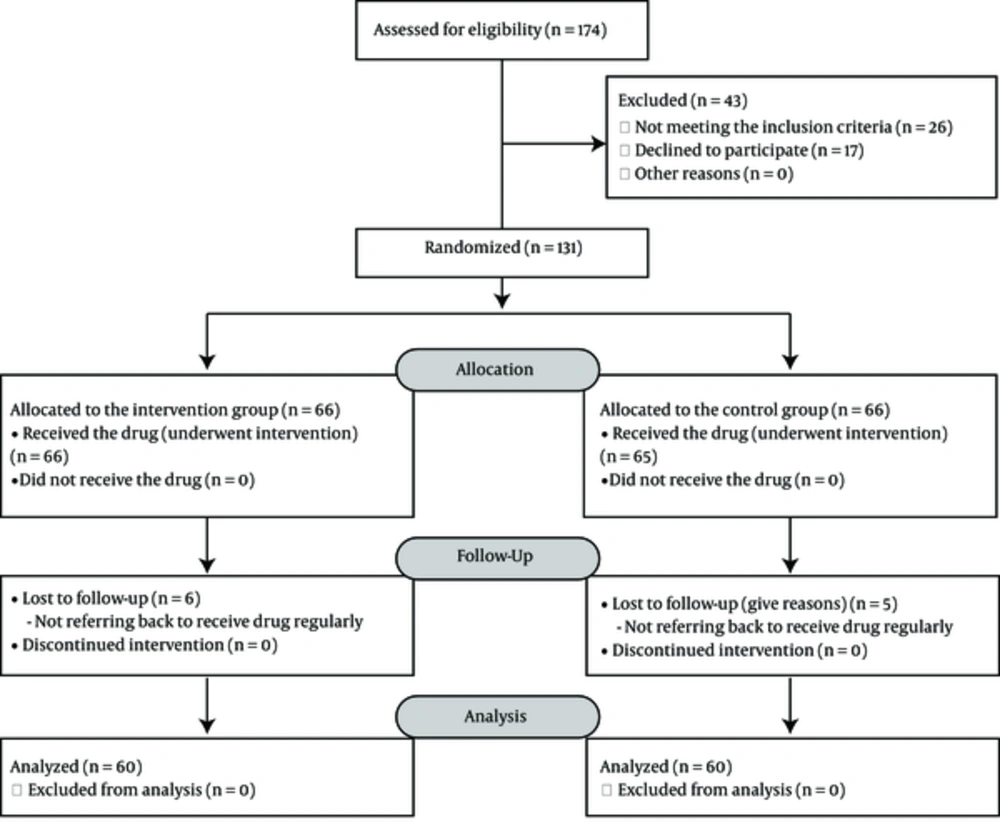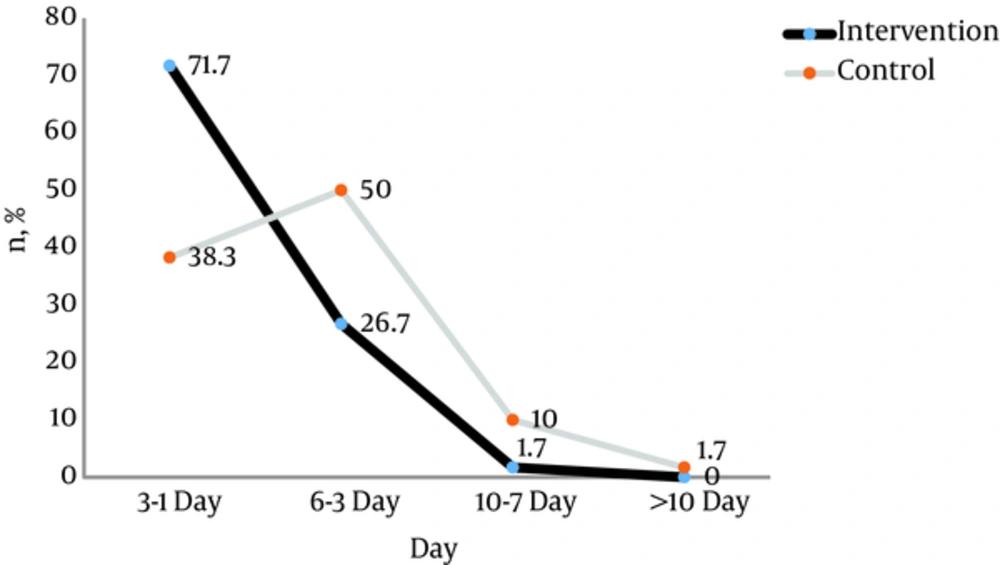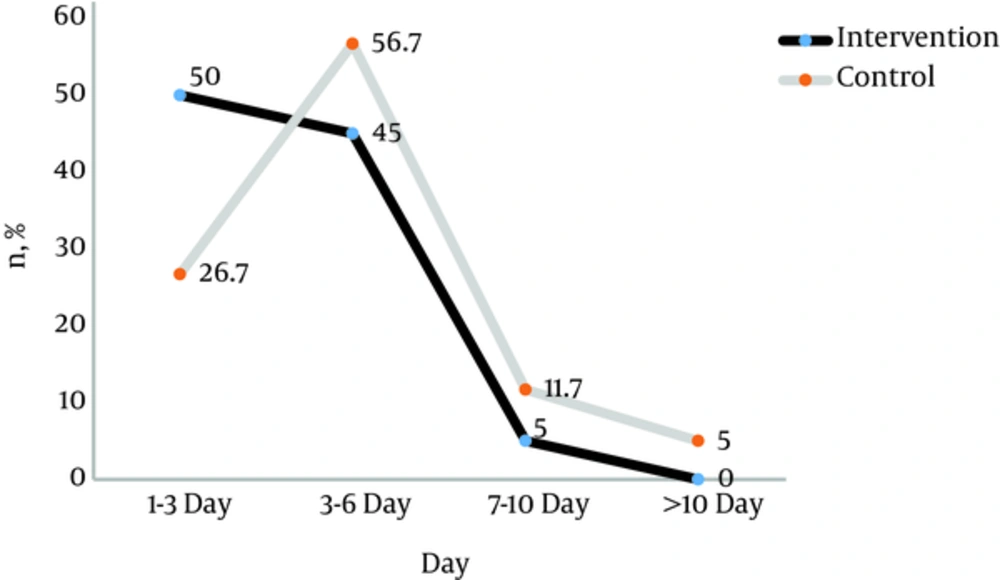1. Background
Cold is defined as a viral infection of the upper respiratory tract. People may repeatedly be affected by this disease throughout their life. As a result, on average, every adults catches cold 2 to 4 times per year and every child catches cold 8 to 10 times per year (1-3). Colds can be caused by various viral agents, among which rhinovirus is the most common (4). Overall, cold is a completely benign disease, however, it could cause significant complications (5-7). This disease is more common in children than in adults and usually requires more attention and care (8). Zinc is one of the micronutrients necessary for growth and proper functioning of the immune system. Mild to moderate deficiency of this nutrient could be easily diagnosed and treated through a positive response to zinc supplements. Zinc supplements have a positive effect on the course of diarrhea and pneumonia as well as children's cognitive performance (9-13). Studies have shown that normal level of zinc could prevent rhinovirus growth and replication in vitro; this might be due to zinc interference with protease c3, which has a role in rhinovirus replication (14). It has also been reported that the administration of zinc supplements, through increasing the level of zinc in the nose, could reduce and alleviate cold symptoms, such as sneezing and nasal congestion (15). Although cold is usually a self-limited and uncomplicated disease, the symptoms and their duration could cause numerous problems for children and their families. Among problems caused by colds, the following could be suggested: social dysfunction due to physical health problems, such as absenteeism from school and kindergarten, impatience, nutritional problems, weight loss, increased risk of secondary bacterial infections in children, increased burden on families and community, increased physician visits, and more frequent visits to the health care system (16-18).
Several studies have been conducted so far to investigate the effect of zinc sulfate on cold disease, however most have been performed on adults. The results of most previous studies have indicated the positive effect of zinc sulfate on symptoms of cold. However, according to other studies, zinc sulfate has no effect on this disease. The difference in the results of various studies may be due to differences in methods, target populations, and dosage and formulation of Zinc sulfate used by the studies (15, 19).
Given the high prevalence and remarkable effects of common cold symptoms in children, finding a way to reduce the duration and severity of symptoms could be of great help to patients, their families, and the health system. Zinc sulfate has no side effects and is easily available. However, only a few studies have been conducted on the effects of this drug on cold in Iran.
2. Methods
2.1. Design
This double-blind randomized placebo-controlled trial (Zinc versus Placebo) was carried out using a repeated measures design.
2.2. Setting and Participants
This study reviewed the files of patients with common cold, who had medical records at Golpaygani hospital in Qom, I.R. Iran, during year 2015. Using the convenient sampling method, from a total of 174 patients, 148 patients that met the inclusion criteria were invited to participate in the study. Consents were obtained from 131 patients, who were enrolled in the study (Figure 1). Using permuted block randomization method, the participants were randomly divided to the intervention group (66 patients, who received Zinc) and the control group (65 patients, who received the placebo of Zinc). Finally, after excluding the patients, who did not meet the criteria, the data was collected from 120 participants. The study was conducted over a period of 3 months (June 2015 to August 2015). Inclusion criteria were the followings: 1, being aged 4 to 8 years old and being affected by common colds along with rhinorrhea; 2, diagnosis of cold symptoms by a pediatrician; 3, not taking antibiotics; 4, parental consent to enroll the child in the study. Exclusion criteria during the intervention were the following: 1, being affected by a systemic disease or immunodeficiency problems; 2, taking immunosuppressive drugs; 3, being affected by a potential drug side effect; 4, worsening patient’s condition; 5, not referring for follow-up examinations; 7, refusal to continue participation in the study. The patients were followed up for two weeks through visits and examinations that were performed every 3 days until complete treatment. Finally, duration and symptoms of colds in both groups were compared with each other.
2.3. Treatment Protocols
Following the treatment protocol, the intervention group received zinc (1 mg/kg) for 7 days and the control group received the same amount of placebo.
2.4. Measurements Tools
The required data were collected using a questionnaire that included items about demographic characteristics (age, gender, education, etc.) and signs and symptoms of disease (rhinorrhea, nasal congestion, nausea and vomiting, fever, and taking antibiotics).
2.5. Ethical Considerations
This study was approved by the ethics committee of Qom branch of Islamic Azad University, I.R. Iran (IR.IAU.QOM.REC.1395.43). In accordance with the Declaration of Helsinki, the ethical considerations were observed. The objectives, process of the study, and probable adverse effects of taking zinc for common cold were explained to all participants and written informed consent was obtained. Participants were free to leave the study at any stage. Also, participants were informed that all costs related to management of any probable adverse effects would be covered by sponsors and their transport costs would be reimbursed.
2.6. Data Analysis
The collected data was analyzed using SPSS version 17 (for Windows; SPSS Inc., Chicago, IL, USA). P values of < 0.05 were considered significant. In this study, descriptive statistics, Chi-square test, independent t-test, and repeated measures analysis of variance (ANOVA) test were used to analyze the data.
3. Results
Based on the results of this study, most of the participants were male (57%) and the mean age of the patients was 5.54 ± 1.43 years (Table 1). In addition, there was no significant difference between the 2 groups in terms of demographic characteristics and disease-related symptoms. Thus, the participants allocated to the 2 groups had similar characteristics and were similar (P > 0.05).
| Patients’ Characteristics | Intervention Group (N = 60) | Control Group (N = 60) | P Value |
|---|---|---|---|
| Age (Mean ± SD) | 5.6 ± 1.4 | 5.48 ± 1.47 | 0.658 |
| Gender | |||
| Male | 35 (50.7%) | 34 (49.3%) | 0.853 |
| Female | 25 (49%) | 26 (51%) | |
| Mother’s education | |||
| Lower than academic level | 12 (33.3%) | 24 (66.7%) | 0.017b |
| Academic education level | 48 (57.1%) | 36 (42.9%) |
Frequency Distribution of the Patients’ Characteristicsa
The durations of runny nose and nasal congestion was shorter in patients in the intervention group, who had received zinc, and were significantly different from the durations in the control group (P = 0.017 and P = 0.001, respectively) (Figure 2).
There was a significant difference between the 2 study groups in terms of the therapeutic effect of zinc on the fever of patients. Accordingly, fever was treated better in the group that received zinc (P = 0.003).
In general, based on the examinations by pediatricians and reports by the parents, there were significant differences between the patients, who received zinc and those, who did not receive the drug in terms of the duration, severity of signs and symptoms, severity of illness, and weakness (P = 0.018), so that the highest rate of treatment in the intervention group was observed in the first 3 days (Figure 3).
4. Discussion
In this study, the results showed that the use of zinc sulfate significantly reduced the duration and severity of symptoms in children with colds. Accordingly, such a condition could result in a decline in social, educational, and economic functioning of children and their families.
In a study by Michael Allan et al., the researchers reported the positive effect of zinc sulfate on colds and thus recommended the use of zinc sulfate supplementation in children with colds (20). However, some other studies did not report, such positive effect (19, 21, 22). In a study by KurugoL et al., the results showed that zinc had no effect on the duration of the common cold but reduced the severity of the disease (23). The controversies observed in the results of different studies might be attributed to differences in culture and ethnicity of patients in different studies, differences in study methods and tools for data collection and tracking of patients, and the differences in the type and amount of zinc sulfate administered for the patients. In a systematic review and meta-analysis of randomized controlled trial (2012), which examined the effect of zinc sulfate on the common cold, the results showed that zinc sulfate had a positive impact on the duration of cold symptoms (15). Various researchers in their studies have suggested using zinc sulfate as a prophylactic approach; for instance, in a study conducted by KurugoL et al., the results showed that the number of people affected by cold as well as the severity and duration of cold was significantly lower in the persons, who received zinc sulfate during the study period as a prophylactic treatment, as compared with patients, who were taking the placebo (16). The positive effects of such a prophylactic approach might be attributed to the fact that currently people are experiencing deficiency in micronutrients, including zinc. Thus, such a prophylactic approach could compensate and eliminate the deficiency, enhance body's immunity, and subsequently result in better disease outcomes.
Since cold is a viral disease, it primarily requires a supportive therapeutic approach. In this regard, the medical team should try to eliminate disease symptoms as soon as possible and return the patients to routine social functioning. In several different studies that have investigated the effect of zinc sulfate on the duration and severity of cold symptoms, the researchers have recommend to use zinc sulfate in children with colds (15, 23, 24).
Finally, it is recommended to conduct further studies with long-term follow-ups and with larger sample sizes. It is also recommended to use various medicinal forms of zinc sulfate, such as the intranasal form of the drug. In addition, it is better to study patients, who have already been assessed for zinc deficiency. Such an accurate assessment of the effects of zinc sulfate on patients with colds could help propose a comprehensive protocol for the treatment of cold.
4.1. Limitation and Strengths of Study
One of the strengths of this study is the significant effect of zinc on the symptoms of children with colds, and since the nature of colds is such that the symptoms often cause discomfort to patients, a therapeutic approach aimed at eliminating or reducing symptoms can be a rational approach. One of the limitations of this study is the lack of examination of patient’s signs, including laboratory tests. However, considering that the target group of this study was children, they were far more difficult to study compared to adults. Also, due to the high incidence of colds, if more patients were examined, the results would be more likely to be obtained.
4.2. Conclusion
The results of this study showed an overall improvement in the duration, severity of symptoms, severity of illness, and weakness in patients, who received zinc. On the other hand, the study did not observe any significant difference in the group that did not receive zinc. In addition, the highest rate of improvement in the intervention group was observed in the first 3 days. Based on the results of this study and other similar studies, the findings can be utilized by medical teams to adopt a more accurate and complete clinical approach towards the use of zinc sulfate for treating patients with colds.


